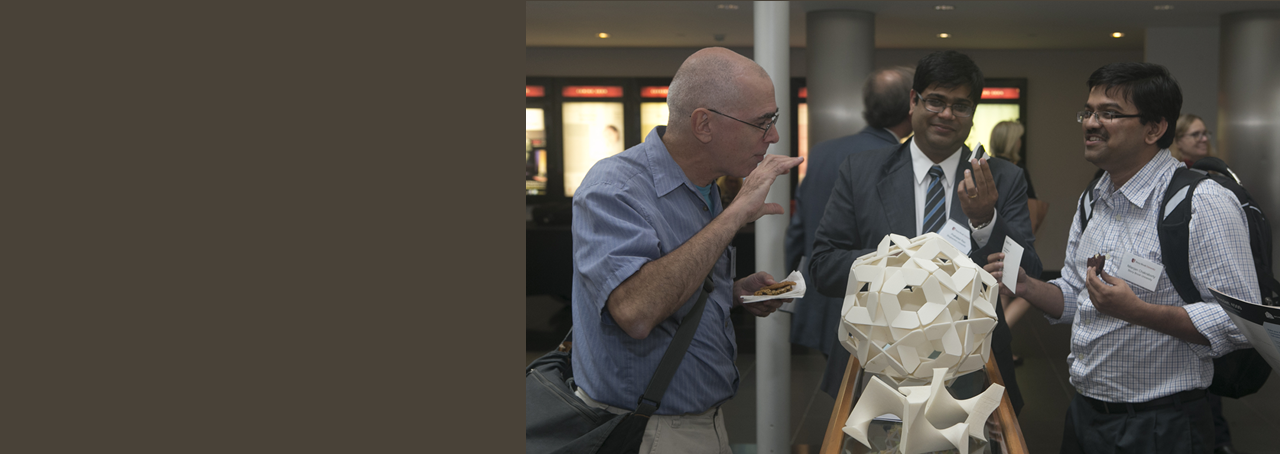Conference explores new opportunities in 3D printing
By Merrill Douglas
Human tissue, fine art, engine components, evening gowns—there’s almost no end to the items emerging from 3D printers these days. Practitioners and researchers in 3D printing, from New York State and beyond, gathered at Stony Brook University this fall to explore the frontiers of this quickly-evolving technology.
“New Horizons in 3D Printing and Digital and Additive Manufacturing,” a conference sponsored by the SUNY Network of Excellence in Materials and Advanced Manufacturing, drew attendees from SUNY university and college campuses, other academic institutions, corporations and industrial consortia.
One goal of the meeting was to help people involved in 3D printing across New York find out what others are doing and discover opportunities to collaborate. “We also brought in people from outside the state who have big initiatives in this area, especially industrial-university collaborations, so we could learn from them,” says conference organizer Gary Halada, associate professor of materials science and engineering at Stony Brook.
The conference was part of an ongoing effort to help New York, by building on existing assets, become a leader in 3D printing and other additive manufacturing technologies.
For Halada, some of the most exciting presentations at the meeting focused on new materials. “For example, one local company is putting graphene—nanoscale sheets of carbon—into polymeric materials to produce a conductive composite you can put into a cheap desktop 3D printer,” he says. The company, Graphene 3D Lab of Calverton, N.Y., says these materials can be used to print fully-functional electronic devices.
Daniel Freedman, dean of the School of Science and Engineering at SUNY New Paltz, was impressed by the broad range of applications discussed at the meeting. “Kanwal Farooqi, from Mount Sinai Medical Center, spoke about using medical scanning data to print a model of a patient’s heart as an aid to doing surgery,” he says. “There was also a nice talk by mathematician George Hart of Stony Brook, who has done a lot of interesting public art that is mathematically designed and then 3D-printed.”
Freedman, who spoke on a panel on industrial-academic research alliances, is also director of the Hudson Valley Advanced Manufacturing Center (HVAMC) at SUNY New Paltz. HVAMC provides 3D printing services to customers in the region while also educating those clients about the technology. The center has garnered significant media attention—for example, for printing a prosthetic hand for a six-year-old boy in Orange County in 2014.
The conference threw a spotlight not only on the variety of 3D printing initiatives in progress, but also the sheer volume. It’s difficult to measure the scope of activity because there is no central source of information on 3D printing in New York, Halada says. As a follow-on to the conference, he plans to create exactly that.
“It will be a prospectus showing what kinds of technologies are being used by whom, where the expertise is, where the new research areas are, what challenges we have to deal with to make this even more applicable to more industries, and where the new opportunities are. A lot of that information started to come out in this meeting.”
Beyond the presentations, the conference was also valuable for the connections forged there. “It helped to get everybody in the state who is interested in this in one place,” Freedman says. “Often at a conference, some of the best outcomes are the discussions you have at lunch and dinner: ‘What are you doing on your campus? How can we collaborate?’”
Halada saw some of those relationships start to gel. “Folks from Buffalo were talking with people from Xerox,” he says. “I saw folks from Binghamton talking with people from Albany and other areas. That’s the whole point of this Network of Excellence – to strengthen New York’s manufacturing sector by bringing these different parties together and breaking down barriers to sharing expertise and infrastructure.”
Since the conference, Halada has been making additional connections—for example, touring America Makes, the National Additive Manufacturing Innovation Institute, in Youngstown, Ohio. “I see a value in New York State becoming involved to a greater extent in consortia like America Makes, so we can stay on top of what’s going on and contribute expertise where possible,” he says.
Halada is working with the University of Buffalo to organize a second conference on 3D printing in 2015. As a next step, he would like to see some seed grants fuel collaborative research, he says. “Whatever can be done to continue these conversations and keep people working together is very important.”
comments powered by Disqus


